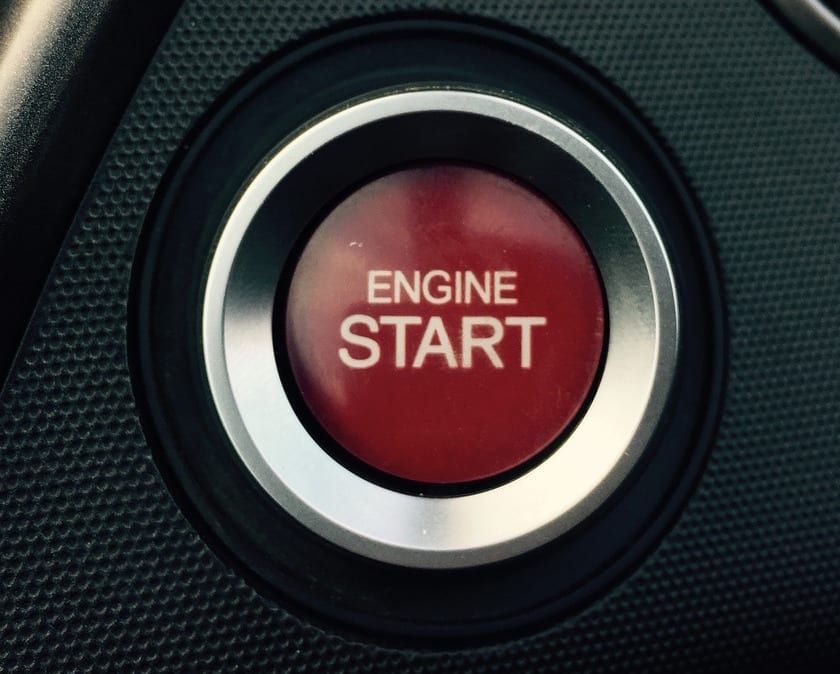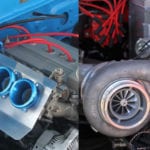If you’re having engine trouble, it’s important to have a little background knowledge before looking for a car repair estimate to get it fixed. I’m talking about your car engine “starting” and “turning over.” Even though it might not seem like it, and people use the terms interchangeably, they have two completely different meanings. The difference between an engine not “starting” and one that isn’t “turning over” can mean either a cheap fix or a costly fix, an easy fix or a hard fix.
Think of this like a crash course on the subject; a crash course that’s oriented towards making sure you know the difference between the two. That way, when you call the maintenance shop you can tell them exactly what’s going on with your car. If you can identify the difference between the two, it will make your life, and the work for your mechanic, much easier.
So…What’s the Difference?
It’s not unusual that people might find this confusing, and if you do, don’t feel bad! It’s easy to mistake one for the other, but also very simple to differentiate one from the other when you know what to look for. So without further ado, here’s a couple of long-winded definitions describing an engine turning over and starting — and a simple way to tell the difference.
Turning Over
Before the engine can start or “fire,” it needs to turn over. The term “turning over” refers to the mechanical process the engine uses to start. That process is the starter engaging the flywheel, the flywheel rotating the crankshaft, and then the crankshaft starting the engine. This is that cranking noise you hear when you turn the key – that fast-paced “ruh, ruh, ruh” noise. If you don’t hear it, that means the engine isn’t turning over.
Starting
When an engine starts, the mechanical process kicks in and then the engine fires. It’s as simple as that, and anything before the engine firing is considered the process of turning over. Now, if you hear the engine attempting to turn over but nothing happens, that means the engine isn’t starting, but it’s still turning over.
There! Glad that’s cleared up! A simple way to remember the difference is this: if you turn the key and nothing happens, the engine won’t turn over. But, if you turn the key and you hear that cranking noise and the engine won’t fire, then it’s not starting.
Why Is The Difference Important?
While you might not think the difference is important, try telling that to the mechanic on the other side of the phone whose ripping their hair out trying to get a quick diagnosis on your car. If you tell them it isn’t starting because nothing happens when you turn the key, you’re going to confuse the poor guy. So would saying your car isn’t turning over when the engine is attempting to start — see how that can be confusing?
Even if you wanted to figure out what’s wrong with it yourself, you could be doing an hour of research on “why my car won’t start?” when, in reality, it’s not even turning over. You will have wasted time on misinformed research and inspecting your car in all the wrong places. Why? Because, different symptoms mean different problems, and the problems associated with your engine not turning over are much different than the problems associated with your engine not starting (but still attempting to turn over).
Just remember the simple signs: turn the key and nothing happens = your engine isn’t turning over. Turn the key and the engine cranks, but doesn’t actually start or fire = your engine isn’t starting.
Identifying the Issue
Taking all of this into consideration, it’s clear that engine trouble isn’t very easy to solve. The engine not turning over or starting are both vague and typically there is no way to immediately tell what the problem is. It involves hours of probing, and a trained mechanic will have a much easier time figuring out what’s causing the engine trouble.
But, if you want to try and figure it out yourself, it’s important to understand that there is one thing that will prevent your car from turning over — and it has nothing to do with the engine itself.
It Could Be Your Battery
The battery is the power hub of your vehicle; without it, your car can’t run. If the battery is dead, it can’t send power to the starter, which means the starter can’t activate the flywheel, and the flywheel can’t crank the engine. There could be nothing wrong with the engine itself trying to turn over, it could just be the battery is out of juice. A good way to tell if your battery is dead is by the lights on the dashboard or radio. If these don’t turn on when you turn the key, then the battery is dead.
This is one of the most common reasons why your car won’t turn over/start, so it’s important to keep it in mind if you are trying to figure out the problem yourself. Make sure to check the battery first if your engine won’t even attempt to turn over; it will save you a lot of time if you find out it’s the battery.
Some Other Causes
Aside from your battery, there are a few other reasons the engine might not turn over or start.
Starter:
The starters in cars have an expiration date and, like everything else, weaken over time. You might notice that it is slow or sluggish in the morning when you first start it. That “ruh, ruh, ruh” noise is now long and dragged out. This is a sure sign that your starter is going and you need to replace it soon. Or the starter could be dead, and that means your engine won’t turn over at all. Which is why, after checking the battery and seeing it has juice, it’s time to replace the starter.
Fuel Pump/Filter:
The fuel pump is an electronic device that sends the fuel from the tank to the engine. If the fuel pump isn’t working, then the engine can’t get fuel. In order to check this, have someone stand and listen to the fuel pump situated at the back of your car as you turn the key. If it sounds like it’s weak or sputtering, or not making any sound at all, chances are it needs to be replaced.
The fuel filter is also part of the fuel system and integral to the engine running properly. These filters can clog over time, and might not be filtering enough fuel through, which means it’s preventing the engine from turning over and starting properly. Thankfully, this isn’t as expensive as fixing a fuel pump.
Ignition System:
The ignition system includes cylinder coils and spark plugs/spark plug wires. Spark plugs and coils also wear down overtime and if you haven’t changed your spark plugs in a while, they could be the reason your engine isn’t turning over.
And Many More Reasons
There are many more reasons why your engine might be having trouble turning over or starting and the most important step when figuring out why is knowing the difference between the two. Without understanding that difference, you might have a hard time trying to describe what’s wrong with your engine. Or worse, you’re going to send your mechanic’s blood pressure through the roof when he or she tries to diagnose the problem.
Understanding the difference is relatively simple once you know what to look for, so pay attention to what happens (or doesn’t) when you turn the key…
Update 5/16/19
If we’ve aimed to drive home any point in particular, it’s the importance of both knowledge and careful distinction when communicating automotive problems. Acknowledging any limitations in your knowledge or diagnostic ability – and letting that shape how you communicate with a mechanic – can help to prevent any confusion, minimizing unnecessary drains on both time and money.
Respect the Professionals
As with most skilled vocations, the majority of mechanics and technicians out there have completed extensive training reinforced by real-world application. In essence, they could be compared with surgeons: knowledgeable in the individual roles played by and interplay between, different components and systems. Up-to-date in terms of the newest developments and best practices. Would you let any random person cut you open, remove or replace parts of your own biology? Of course not. So why would you trust any random person to do the same thing with an expensive automobile?
Granted, not every mechanic or service center is created equal. But you’re as accountable for your long-term satisfaction, as the professionals you place your trust in. The prioritization of preventative maintenance and (when necessary) repairs, understanding that you get what you pay for in terms of both parts and service, and quality of communication can make all the difference in distinguishing a $150 service from a $1500 one.
But What if I Know About Cars?
It’s a fair question. Maybe you were raised under the hood of various cars and trucks, are an automotive enthusiast, or have had some training or professional experience in one of your past lives. Chance are, if you fall into this category, you got three sentences into this article and realized it was beneath you.
That said, you are likely to feel better equipped to troubleshoot most issues, and communicate more effectively with a technician or specialist. And while that may be true in many cases, just remember that the trainer for a college team isn’t licensed to practice sports medicine. If a repair is beyond your skill level, it may also be beyond your ability to properly assess it. And with continual advances in automotive technology, it’s more important than ever not to rely solely on outdated knowledge. You may even want to invest in technology to help narrow a problem down…
Placing Trust in OBD2
To the average layperson, ‘OBD2’ (or OBD II) might sound like the name of some random Star Wars character, but the last couple of decades have increased our general awareness of, and reliance upon these valuable tools. Since 1996, it has been a requirement of all new cars and light trucks to be equipped with an On-Board Diagnosis (OBD) system. This requirement, of course, was extended to all segments (crossovers, for example) in the post-Y2K landscape.
Basically, all vehicles built within the last 24 model years come equipped with an OBD connector port that is required to be (i) placed within three feet of the driver, and (ii) both visible and accessible without any additional, or specialized tools. In most cases, they can be found beneath the dash, or in some facet of the center stack. That port is designed for universal compatibility with various OBD scanners, often referred to as ‘diagnostic readers’ (among other aliases). Of course, there are far more nuances to OBD2 compliance and operation than we’ll cover in this particular piece, but it’s good to have a general awareness of how they work.
The purpose, of course, is to simplify and standardize the diagnosis of automotive issues. The inclusion of the ‘2’ simply marks the evolution of the technology and the more expansive nature of its capabilities. Post-96 vehicles are equipped with both software and firmware, designed to communicate various mechanical and operational issues through the emission of distinct ‘codes’. Those codes are then interpreted through the reader handset or console, providing the user with some direction as to the possible issue, area or operating system requiring attention. Simple enough, right?
But with personal diagnostic readers having grown far more commonplace in recent years, it could be argued that owners have gained a top-heavy sense of confidence when it comes to diagnosing their vehicle woes. One might liken it to the oft-lamented popularity of online sources like WebMD. Suddenly, we’re creating entire generations of potential hypochondriacs misdiagnosing themselves with major issues, because it’s more time-effective than taking the time to visit their PCP (Spoiler Alert: the majority of you are not doctors). That said, the same goes for automotive diagnoses; with there being countless nuances to the interpretation and investigation of codes, and subsequent troubleshooting of the vehicle itself.
Consider, for example, the dreaded ‘Check Engine’ warning light. Illumination of this particular dashboard terror has sent many-a-driver into a tailspin of panic. Fearing costly engine repairs many find themselves stranded between a desire to procrastinate (maybe the light will go off if I drive it long enough for the code to cycle out) and to seek immediate help. But many things can trigger the Check Engine signal, from a loose or missing gas cap, faulty O2 or airflow sensor, misfiring spark plug(s) or catalytic converter (just to name a few). A large segment of drivers, however, would be likely to misdiagnose the root problem causing unnecessary stress and/or expense.
Bottom-line, OBD scanners are available and affordable. However, as with any tool worth having, it’s important to refrain from casual or misinformed use. In the hands of someone with practical knowledge, it can be a helpful aid – otherwise, diagnosis might be best left to professionals. It’s equally important to understand that you get what you pay for. Professional diagnostic systems used by garages and service centers cost hundreds – even thousands – of dollars. In other words, don’t expect a $40 handheld reader to be the solution to all of your automotive woes, or to offer the array of functionality that a device 10x its price would.
Communication is Key
Whether you’re comfortable with automotive technology, or it’s largely a foreign language to you, effective communication is key.
- Explain the problem that you’re experiencing, and the frequency with which it occurs.
- Steer away from technical talk, or any attempts to ‘diagnose’ the problem for them. A good mechanic is likely to prefer their own deductive processes.
- If you have taken any steps to troubleshoot the problem, you can let them know what those steps were – but defer to their judgment.
- Be prepared to answer any exploratory questions that might help the mechanic or service manager to better understand your concerns.
- If needed, in order to help communicate the problem, present the option of a test drive.
- If specific, or additional services are required – specify it/them accordingly. As skilled as mechanics and technicians are, they’re not mind readers.
At the end of the day, engine trouble is just part of the puzzle. If we’re going to address car repair in a more general sense, it would take a lot more space and a lot more time. That said, you (as the owner) play a more important role in the process of car repair than you realize. Recognizing your knowledge level (or lack thereof), making use of the tools you have available to you and practicing effective communication with trained professionals can help to secure the best possible service, and the greatest possible level of satisfaction.







